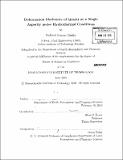| dc.contributor.advisor | Brian J. Evans. | en_US |
| dc.contributor.author | Bakku, Sudhish Kumar | en_US |
| dc.contributor.other | Massachusetts Institute of Technology. Dept. of Earth, Atmospheric, and Planetary Sciences. | en_US |
| dc.date.accessioned | 2010-10-29T18:40:01Z | |
| dc.date.available | 2010-10-29T18:40:01Z | |
| dc.date.copyright | 2010 | en_US |
| dc.date.issued | 2010 | en_US |
| dc.identifier.uri | http://hdl.handle.net/1721.1/59787 | |
| dc.description | Thesis (S.M. in Geophysics)--Massachusetts Institute of Technology, Dept. of Earth, Atmospheric, and Planetary Sciences, 2010. | en_US |
| dc.description | Cataloged from PDF version of thesis. | en_US |
| dc.description | Includes bibliographical references (p. 92-97). | en_US |
| dc.description.abstract | Pressure solution is a naturally occurring deformation process in fluid-bearing rocks, with implications for sediment consolidation rates and deformation in the mid to upper crust. The process involves dissolution at asperities under load; diffusion along grain-to-grain contacts; and precipitation in the pore space. The kinetics of the process and the identity of the rate-limiting step in quartzose rocks are still a subject of debate and depend critically upon the structure of the inter-granular boundary during deformation. To investigate the mechanisms and kinetics of pressure solution and the effects of changes in boundary morphology, we continuously monitored deformation and the evolution of boundary morphology at a Y-cut convex quartz lens that was pressed against a flat surface of Y-cut quartz under hydrothermal conditions (425 0C, 150 MPa fluid pressure, 80-435 MPa effective normal stress) in a see-through optical pressure vessel. The pore fluid was de-ionized water, which became saturated with quartz during the initial heat-up period. Several different boundary morphologies were used, including polished flats, etched and roughened flats, and an island-channel structure fabricated by plasma etching. The island-channel structure had square pillars of quartz, either 4 micro meter or 8 micro meter on a side, surrounded by an inter-connected grid of open channels of comparable width. Deformation at the interface between the quartz flat and lens (i.e., inter-granular convergence) was observed in only one case: the 4pum island-channel structure. In that instance, pillars within the contact region were eroded at a rate that decreased with time, and SEM photomicrographs after the experiment showed significant cataclasis within and adjacent to the pillars. The total transient convergence (0.15i0.02pum) observed during the 472 hour period was less than the original pillar height (0.55±0.005pim). For all surface morphologies, the shapes of the surface structures in both the loaded and unloaded regions evolved, perhaps owing to capillarity forces. Although an inter-connected island-channel structure was initially imposed upon some of the experiments, this open, fluid-filled boundary structure was seen to be a transient phenomenon that was largely destroyed during convergence. Thus, there was no evidence for a dynamically stable interface, as previously suggested. | en_US |
| dc.description.statementofresponsibility | by Sudhish Kumar Bakku. | en_US |
| dc.format.extent | 97 p. | en_US |
| dc.language.iso | eng | en_US |
| dc.publisher | Massachusetts Institute of Technology | en_US |
| dc.rights | M.I.T. theses are protected by
copyright. They may be viewed from this source for any purpose, but
reproduction or distribution in any format is prohibited without written
permission. See provided URL for inquiries about permission. | en_US |
| dc.rights.uri | http://dspace.mit.edu/handle/1721.1/7582 | en_US |
| dc.subject | Earth, Atmospheric, and Planetary Sciences. | en_US |
| dc.title | Deformation mechanics of quartz at a single asperity under hydrothermal conditions | en_US |
| dc.type | Thesis | en_US |
| dc.description.degree | S.M.in Geophysics | en_US |
| dc.contributor.department | Massachusetts Institute of Technology. Department of Earth, Atmospheric, and Planetary Sciences | |
| dc.identifier.oclc | 671398776 | en_US |
